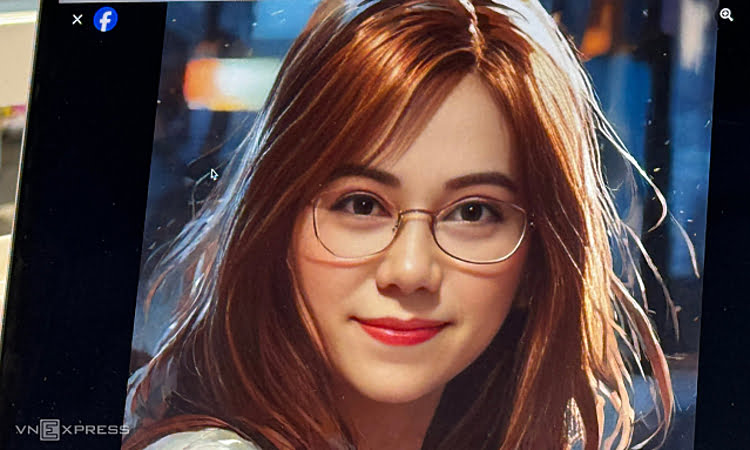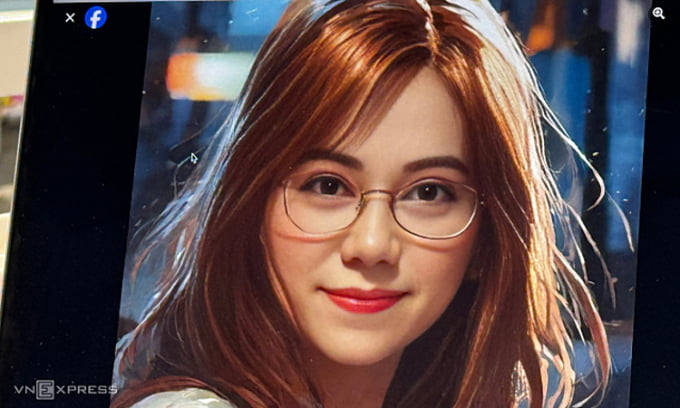
Hoai Anh, 25 years old in Hanoi, said that before the AI fever broke out, she and many of her friends on social networks often uploaded photos to editing apps to beautify their faces and then posted them on Facebook. . Therefore, she thought her photos had been collected by a series of applications a long time ago and did not care how the data was later exploited by other parties.
“I was worried when I read the warning about the risk of deepfake face transplants. But having accidentally shared information with dozens of different applications for many years, perhaps my facial data has become uncontrollable on the Internet. “, she said.
Hoai Anh is not an isolated case. Many VnExpress readers also commented that “personal information has more or less been collected, there is nothing left to lose”.

A photo created with Zalo AI. Photo: Tuan Hung
Recently, a series of AI image creation trends have appeared, attracting great attention. In the past three days, Vietnamese social network users have shared a series of photos created by AI Avatar inside the Zalo application. To use, the app requires permission to access the photo store or camera, and select a photo with a clear face. Users also need to enter some information about gender, age, and desired photo style. Previously, some applications such as Lensa , Loopsie , Reface also caused fever in Vietnam.
According to a representative of Vietnam’s Anti-Fraud Project, not everyone carefully studies the terms of use and privacy policy of the service. “Users using the application also agree to the terms, in which the service and platform may have terms that are disadvantageous to them in the future,” the project representative said.
And Mr. Vu Ngoc Son, Technology Director of NCS Cyber Security Company, said that even though the user’s operation is simply to upload the original photo and receive a new photo, this action still has potential risks, due to its nature. is a photo that has been uploaded and then still stored at the service provider’s server system.
“Concentrating images in one place will put you at risk of being leaked or attacked by hackers. If the photo archive falls into the wrong hands, they can use deepfake to create fake photos and videos for different purposes.” , even fraud,” Mr. Son advised.
In the context of deepfake attacks flourishing, allowing bad guys to create fake images, fake news, and video calls pretending to be other people, sharing personal images is constantly being warned. However, many people still appear subjective. “Dozens of applications on phones already request access to photo storage. Is it still meaningful to protect against a certain application now?”, member Nguyen Hung asked on a technology forum when advised to reduce Use AI applications.
According to the representative of the Anti-Fraud project, Nguyen Hung’s question is “somewhat correct”, but shows a lack of responsibility for personal data as well as the safety of users and those around them.
“Thinking like that is subjective, making it difficult to protect yourself in cyberspace. Once data is exploited, the person who suffers is not only that person, but also family and friends. and everyone around,” this expert said.
“You may have been exposed before, but that is old data and may no longer be true today. Besides, data collected through intermediary systems will have lower trust, less High potential for error. Therefore, operators will always want to have the latest data and in the most direct way,” Mr. Son said.
At the digital transformation event in early October, the Department of Cyber Security and High-Tech Crime Prevention (A05) – Ministry of Public Security also assessed the awareness and sense of personal data protection of a department. People are not yet ready to trade their information for the convenience of services.
Meanwhile, Zalo representatives have not commented on the platform’s user data protection mechanism.
Previously, at a meeting of the Ministry of Information and Communications on September 6, the Information Security Department also mentioned and evaluated the use of face photo editing applications that pose hidden risks. Face is one of the important data today, such as for account authentication. With deepfake, facial data can be exploited to create fake images and copy other people’s portraits. “From this connection, we assess that the use of photo editing applications poses a potential risk of information insecurity,” said a representative of the Department.
Experts recommend that users need to be aware of protecting their personal data, only provide truly necessary information, carefully check the terms of use, and know clearly that the information they provide will be used. for what purpose? With photo editing apps, users can use the protection mechanism of the smartphone operating system by not allowing access to the full photo archive, only uploading photos for editing purposes, and minimizing photo editing. contains sensitive content.
Luu Quy

Leave a Reply
You must be logged in to post a comment.